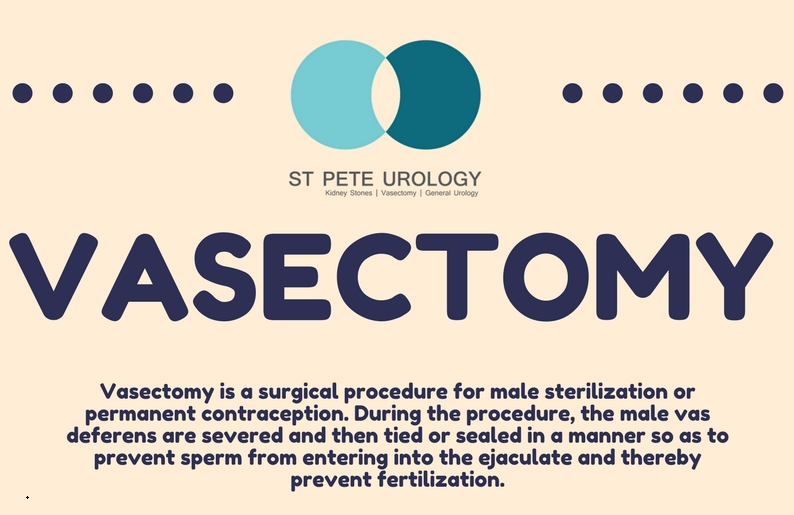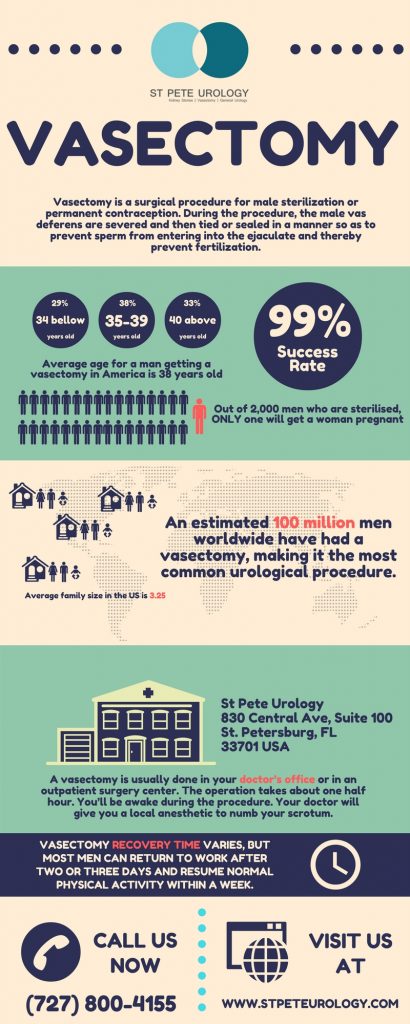If for some reason, such as a remarriage or loss of a child after a vasectomy, you choose to have children, can you get a vasectomy undone? Certainly yes! In fact, you can have a vasectomy undone even after a period of time as long as 25 years. However, at St Pete Urology, we are aware that some people may misuse this procedure. For this reason, we are committed to open and informative discussions with our patients before they have a vasectomy, ensuring they know that vasectomy is a permanent birth control method which they should undergo only when certain that they no longer want to have children. We also inform them of the option of vasectomy reversal but only as an ideal option when there is a drastic change of circumstances and a pressing need to have children after a vasectomy.
Outpatient procedure
Vasectomy reversal is often done as an outpatient surgery performed under localized, regional or general anesthesia. Executed with the help of an operating microscope and taking 3-4 hours, vasectomy reversal involves reconnecting the two severed ends of the vas deferens to allow sperm to be transported out of the body. Most men are eligible for a vasectomy reversal, but we usually go through the procedure in detail with our patients to ensure it is right for them.
Techniques for reversing a vasectomy
Before embarking on a reverse vasectomy, the urologist checks for sperm within the vas deferens. The presence or absence of sperm determines the type of surgery performed by the doctor. For instance, if sperm is found within the vas, the urologist will simply need to put the two ends of the vas deferens back together in order to restore male fertility. This procedure is called vasovasostomy, a sewing back together of the severed ends of each tube that carries sperm. In other cases, a blockage closer to the testicle may prevent sperm from reaching the vas. This calls for a more complicated surgery called vasoepididymostomy, which bypasses the blockage. Vasoepididymostomy involves connecting the vas deferens directly to the epididymis (a small organ located at the back of every testicle and which holds sperm).
High success rate
A vasectomy reversal is a more complex procedure that requires more expertise and experience than the original vasectomy. Therefore, it is important that you work with a surgeon who performs vasectomy reversals on a regular basis and who has a track record of success with both types of reversals. When properly performed, vasectomy reversal has a high success rate of 80-95 percent. In fact, the return of sperm (potency rate) is as high as 95 percent, while pregnancy rates vary from 50-70 percent. However, the likelihood to achieve pregnancy after a reversal depends on various factors, including experience of the surgeon, length of time since the vasectomy was done, tissue or tube damage that occurred during original vasectomy, and fertility status and age of your female partner.
Recovery after a reversal
After reversal surgery, it takes 5-14 days to recover. Vasectomy reversal is a minimally-invasive procedure that will not have a heavy toll on your body so you may only expect some soreness in the scrotal area, but this can be relieved with pain medication. However, sexual intercourse and heavy lifting should be avoided during the first 4 weeks after surgery. Your doctor will assess the success of reverse vasectomy by examining your semen 6-8 weeks after the operation. Sperm quality will return to normal 3-6 months after reversal surgery.
At St Pete Urology, we have state-of-the-art facilities, experienced urologists and a patient-centered multidisciplinary approach to ensure your vasectomy reversal is an absolute success. For more information, visit the “St Pete Urology” site.








